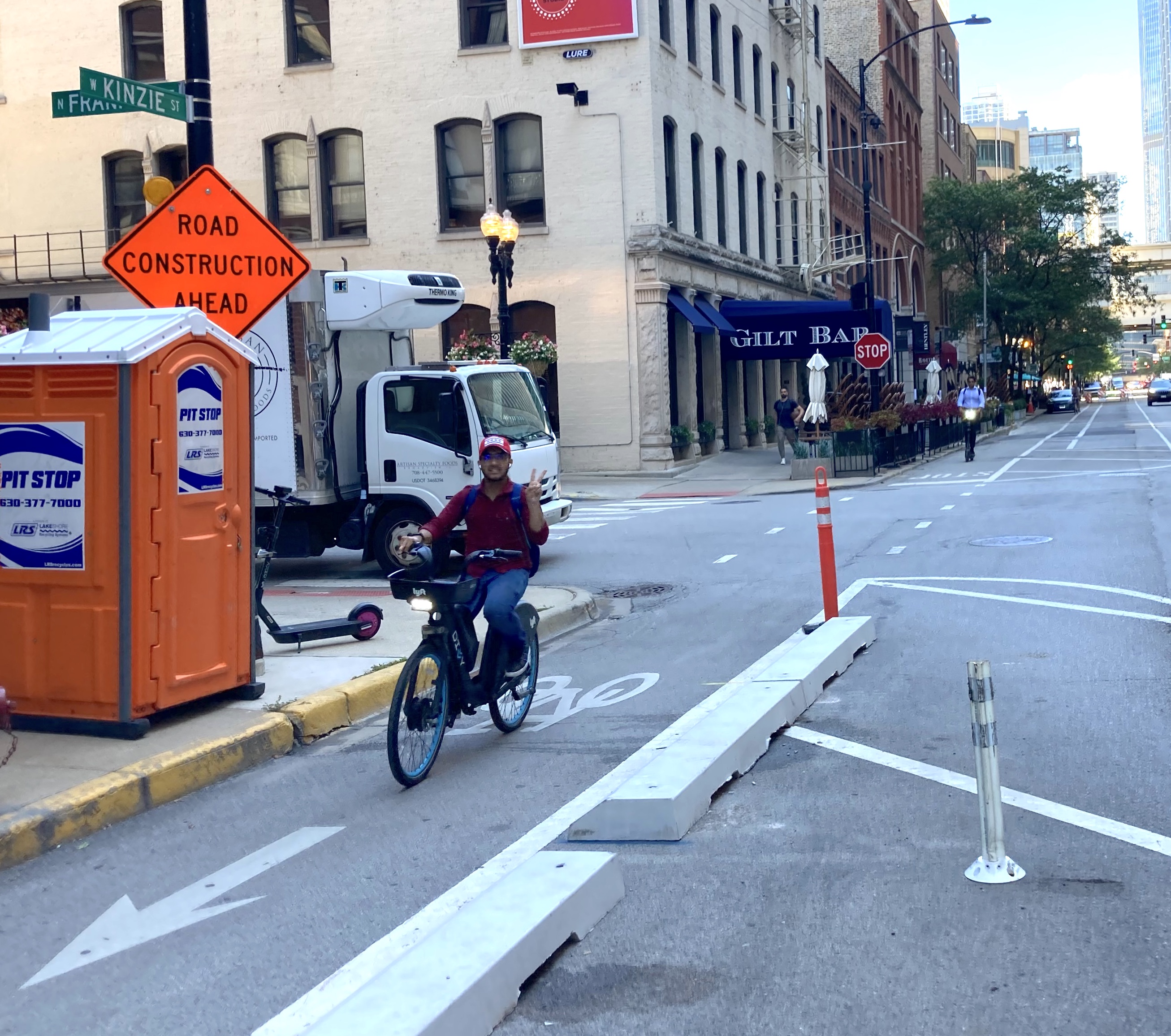On June 29 the Chicago Department of Transportation outlined plans to add concrete barriers to all the city’s plastic post-delineated and/or parking-protected bike lanes by the end of 2023. The project will include 25 miles of bikeways, including 15 miles of existing lanes and ten miles of new bikeways. From now on, concrete protection is supposed to be the default treatment for protected lanes.
One of the first existing bikeways to get a concrete upgrade a few weeks ago under the new initiative was Kinzie Street. That was appropriate because it was the site where Chicago's first protected bike lanes were installed in 2011. The Kinzie bike lanes were generally located curbside and protected by the parking lane and/or flimsy plastic posts. The latter don't actually do much to prevent motorists from parking, driving, or striking bike riders in the bike lanes. Therefore, adding robust physical protection is very important for making the bikeways safer and more appealing to less-confident cyclists.
The upgrades on Kinzie run 0.8 miles from Desplaines Street (630 W.) to State Street (0 E/W), mostly in the River North community. CDOT bolted down precast curb sections on much of the corridor, which is a good strategy. Compared to curbs that are constructed on location, the prefab curbs can be installed relatively quickly and affordably, and can be easily relocated if the design needs to be tweaked. Overall this project is a step in the right direction.
But it would be misleading to say that, as it stands, the entire stretch has gotten a concrete upgrade. In reality, so far less than half of the corridor has received curbs, shown as green lines in the map below. According to a CDOT official, the department is waiting on utility work at Kinzie and Wells Street (200 W.) to be completed before adding more curbs.

At the moment, the rest of this road segment generally has bike lanes painted to the left of the curbside parking lane, a type of bikeway that detractors call a "door zone lane" (shown in orange on the map.) In fairness, CDOT generally painted these solid green, which makes it more likely drivers will notice them, a slight upgrade from the status quo. But plenty of motorists are still parking and driving in these non-protected lanes.
It's also worth noting that all the new curb protection is located on the less busy half of the Kinzie corridor, west of Franklin Street (300), where it's least needed. Worse, there are a couple of stretches (colored red on the map) where the south sidewalk is impassible, and as a result portable concrete Jersey barriers have been set up to create a protected walkway in the street for pedestrians. That means bike riders are forced to share a travel lane with drivers, which isn't at all safe or comfortable.
Let's take a visual tour of the new bike facilities on Kinzie as they appeared Tuesday afternoon, from west to east. We'll also take a brief look at the new temporary protected bike detour CDOT set up on Clark Street (100 W.) and Wacker Drive (300 N.) while the Dearborn Street (30 W.) bridge is being rehabbed. (Currently one northbound lane on Dearborn is open, but it's not really safe to bike on.)
Starting out at the five-way intersection of Kinzie, Desplaines, and Milwaukee Avenue, the bike lane on the north side of Kinzie by the fragrant Blommer Chocolate Company building is still non-protected, presumably so that semi truckers can park curbside. But there are occasional curb sections in the parking-protected lane on the south side of the street.
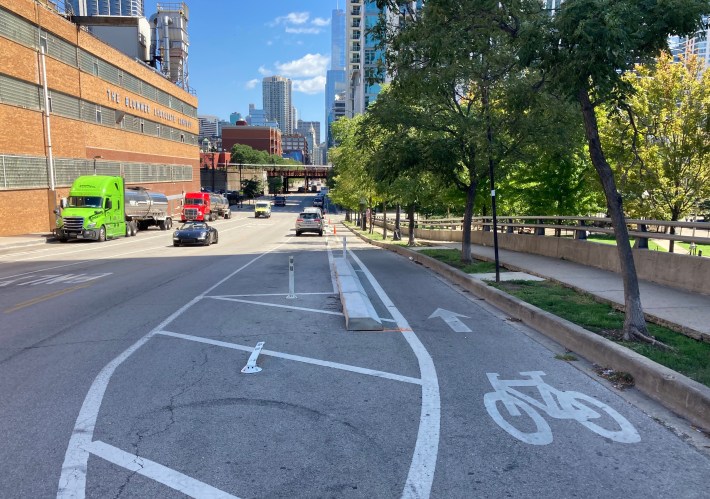
East of the Willie Wonka-esque factory there are parking-protected bike lanes with curbs on both sides of the street. When I passed by a FedEx truck was partially blocking the eastbound lane at Clinton Street (530 W.), just before a Metra viaduct.

Many of the curbs currently have orange traffic cones at either end. According to CDOT spokesperson Erica Schroeder, the department will be adding white plastic posts in between the curbs, where the cones currently are, as well as "yellow reflective delineators to the curbs at entry points to help with visibility." Simply painting the curbs a bright color would also be helpful. I've heard several stories of pedestrians who've been injured after tripping on a bike lane curb, and even tales of bike riders who've wiped out on them.
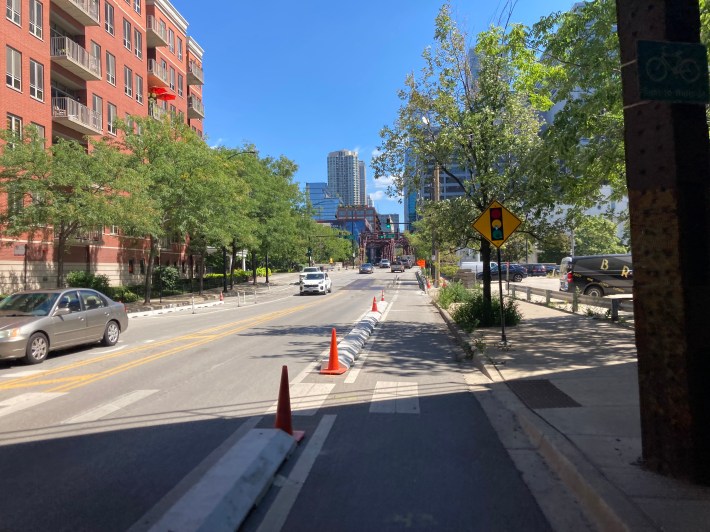
The curb protection drops out before, during, and after the Chicago River bridge. And even the flexible posts that used to delineate the bike lanes on the bridge have all been taken out by drivers.
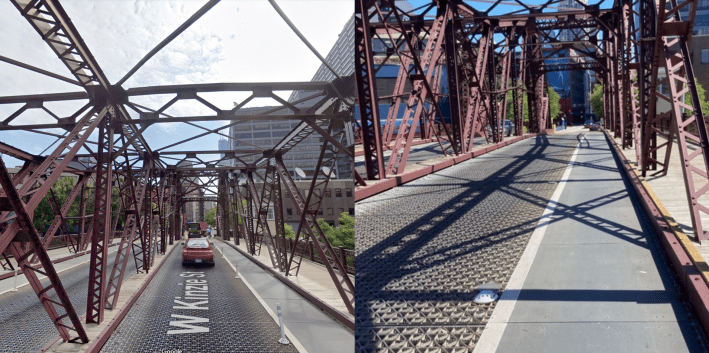
Curb protection resumes on both sides of the street near the Merchandise Mart. There's no sidewalk on the south side of Kinzie in this area, so surely people are walking in the bike lanes at times, as they did before the concrete was added.
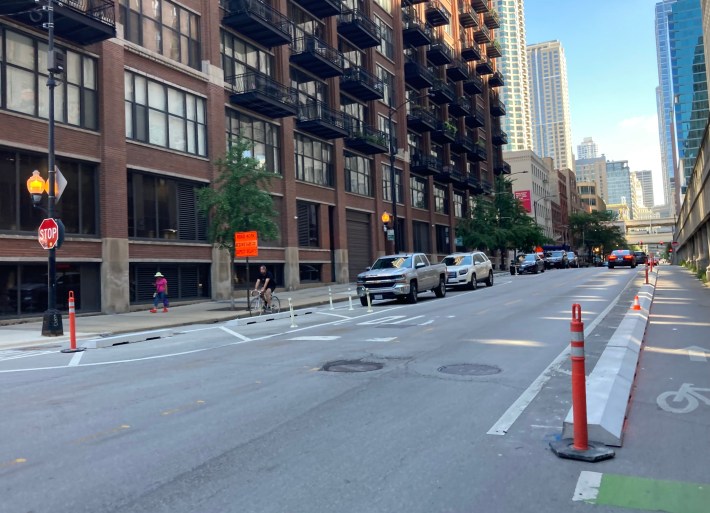
The curbs disappear from both sides of the street east of Franklin. Hopefully concrete will be added here once the utility work near Wells is done.

East of Wells there are green-painted non-protected bike lanes on both sides. That's where we encounter one of the first problem areas. Due to a sidewalk collapse in front of the Antiquarian Buildings pedestrians are forced to walk in the street, which has Jersey barriers to protect them. But that forces bike riders to merge into the travel lane. It's been like this for weeks, and it's unclear if CDOT plans to fix the problem in the foreseeable future.
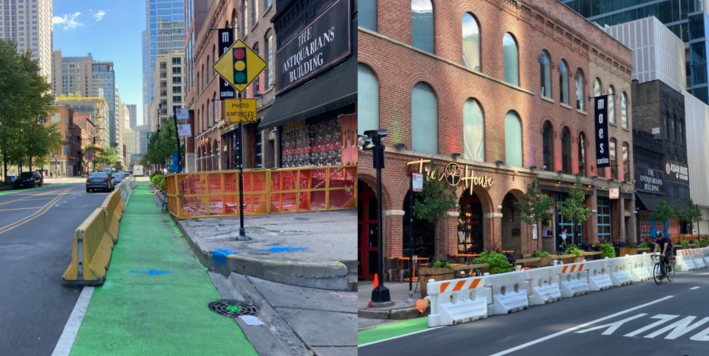
At the southeast corner of Kinzie and LaSalle Street (130 W.) both a USPS truck and a FedEx vehicle were parked in the non-protected bike lane. That also forced people on bikes to merge into traffic.

While the situation in front of the Antiquarians Building is somewhat understandable, the other problem spot on the south side of Kinzie east of Clark is pretty infuriating. There would be plenty of room for a curb-protected lane here. But to accommodate outdoor seating areas that take up the entire wide sidewalk in front of the Barrio and Siena Tavern restaurants, once again a protected pedestrian walkway has been set up in the street. Not only does that detour inconvenience sidewalk users (especially people in wheelchairs), it makes conditions riskier for bike riders. It's way more important for public right-of-way to be used to protect vulnerable road users than for drinking Margaritas and Negronis!
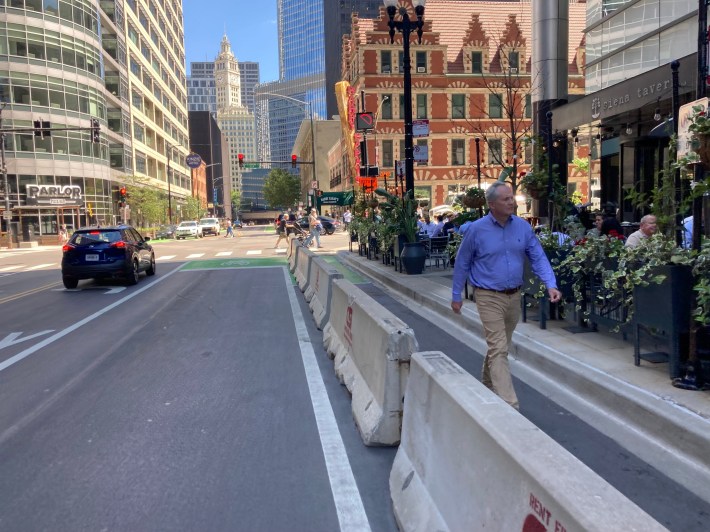
The last block of the Kinzie bikeway, between Dearborn and State, has non-protected green bike lanes. After that there are no bike facilities east of State, or on State itself.
Backing up to Clark Street, the temporary bike detour CDOT set up isn't terrible. There are flexible post-delineated bike lanes on both sides of Clark, a one-way southbound street, with parking protection for the northbound bikeway (although the buffer next to the parked cars is too narrow, creating a dooring hazard.)
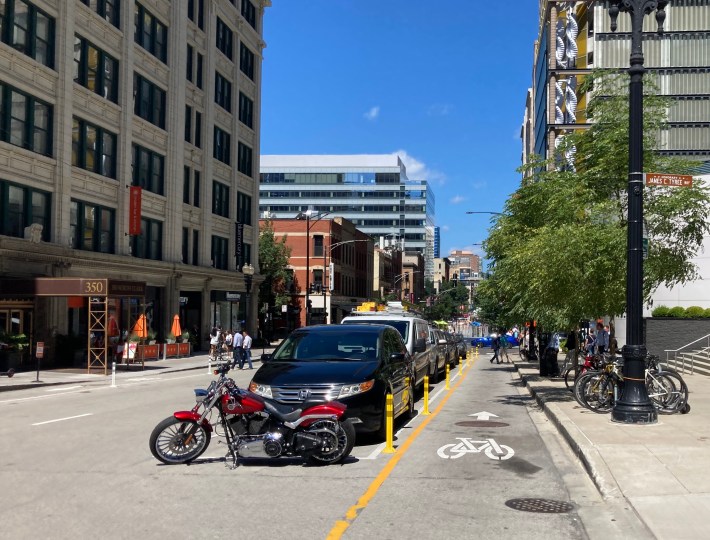
As you bike north of the Clark bridge in the bike lane, there's a sketchy situation due to a midblock crosswalk with a stoplight just north of the span, with poor sight lines for cyclists. You can see the problem in the video below, shot by a person pedaling an electric-assist tandem bike with another rider.

While southbound drivers have a red light when pedestrians have a walk signal, there doesn't appear to be a signal for northbound bike riders. You can see the problem in the video below. Fortunately it looks like no one was hurt, but be sure to look out for people crossing when you're cycling north here.
Welp, we hit our first ped today. We were probably going 20mph, maybe 400lbs, 2 adults + bike and came to a stop on nearly a dime. I was able to turn the wheel so I just clipped her. She seemed ok, we were ok. 😬@ternbicycles #BikeChi pic.twitter.com/jSEJRElnZ6
— 🚲 Sharr🌼ws R. Bullshit 🚲 (@chiyclist) August 31, 2022
To end things on the positive note, the temporary Jersey wall-protected two-way bike lane on the north side of Wacker Drive between Clark and Dearborn is great. While you're cycling east-west, it offers near-total protection from reckless drivers. (One fly in the ointment is that many drivers heading north on Dearborn and turning left onto Wacker have been disobeying their signal endangering cyclists turning left into the curbside lane, so be careful when making that move on a bike.)

Establishing the Wacker bike lane involved converting a travel lane, but there are still six lanes for drivers left on the massive road. There should be permanent lanes like this along the entire length of Wacker, and all over Chicago.
